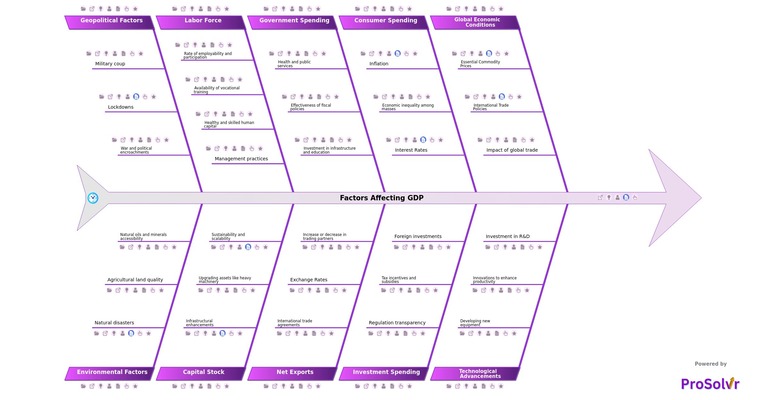Root Cause Analysis of the factors affecting GDP
Learning from the factors affecting GDP provides a comprehensive understanding of economic dynamics. By analyzing these factors with the help of Root Cause Analysis (RCA), conducted through Fishbone analysis or the Ishikawa diagram, one can develop targeted strategies based on Six Sigma principles to enhance economic performance, address challenges, and capitalize on opportunities for sustained progress.
Understanding the factors can provide valuable insights into several aspects of economic performance and development. GDP is influenced by a complex interplay of various factors, including consumer and business behavior, government policies, imports and exports, technological advancements, and global economic conditions.
Some other aspects include the correlation between labor force participation and productivity. By examining GDP factors, one can gauge the current state of the economy, and its strengths and weaknesses. Applying the 5 Why’s principles can improve problem solving, problem analysis, and problem resolution processes.
Incorporating visual root cause analysis can effectively and efficiently identify underlying issues and trends in GDP factors. Higher GDP generally correlates with improved living standards, access to services, and overall well-being of the population. By leveraging advanced problem-solving techniques and visual tools, stakeholders can drive economic growth and ensure sustained progress.
Quality tools like ProSolvr can enhance these analyses, making the data more accessible and actionable for decision-makers.
Who Can benefit from GDP Analysis template?
The factors affecting GDP are crucial for a broad spectrum of stakeholders, including:
- Policymakers: Develop strategies to foster economic growth and stability.
- Economists: Gain insights into economic performance and trends.
- Investors: Predict market movement more effectively.
- Stock market analyzers: Analyze market trends and opportunities.
- Governments: Plan better monetary and fiscal policies.
- Crisis management teams: Develop better crisis management strategies during economic setbacks.
- Businesses: Identify potential market opportunities and areas for expansion.
- General public: Understand the state of the economy and its impact on living standards.
Why use the GDP Analysis template?
Insights into GDP factors can guide the development of long-term economic strategies and policies aimed at sustainable growth and stability. Using this template can help in:
- Policymaking: Informing the development of policies for economic stability and growth.
- Economic Analysis: Enhancing understanding of economic performance and trends.
- Market Prediction: Assisting investors and stock market analyzers in predicting market movements.
- Crisis Management: Improving preparedness and response to economic shocks such as financial crises, natural disasters, or pandemics.
- Business Strategy: Identifying market opportunities and areas for business expansion.
- Problem-Solving: Employing GenAI-powered root cause analysis for better scrutiny and resolution of economic issues.
Draft and create a template for problem analysis in ProSolvr by smartQED.
Curated from community experience and public sources:








